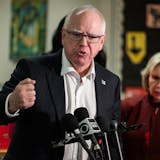A new state report finds Minnesota's uninsured rate basically held steady through the first five months of the pandemic, with growth in government-based coverage offsetting declines in private health insurance provided by employers.
Whereas an estimated 264,400 people, or 4.7% of state residents, lacked health insurance coverage in October 2019, the number by July 2020 was down slightly to 258,600 people, for a rate of 4.6%, according to numbers released Tuesday by the Minnesota Department of Health.
Minnesota reported its first COVID-19 infection in March. Between April and July, enrollment in private coverage declined by about 29,500 people, according to the report, while government-based coverage grew by 43,700 during the time period.
Growth was concentrated in Medical Assistance, which is Minnesota's version of the state-federal Medicaid program.
"The investments we made before and during the pandemic to ensure Minnesotans had access to affordable health coverage helped more people stay insured, even in the midst of job losses and economic instability," state Health Commissioner Jan Malcolm said in a statement.
At the outset of the pandemic, Health Department researchers feared there might be widespread coverage losses among those with job-based health insurance, leaving many Minnesotans without financial support for obtaining care in the middle of a public health crisis.
In the end, though, government programs provided coverage for more low-income people as support for employers seemed to help prevent some losses in job-based coverage, said Stefan Gildemeister, the state's health economist.
Minnesota is letting people who otherwise would have had to renew eligibility for Medical Assistance and MinnesotaCare remain enrolled in the insurance programs, the Health Department report noted. The state's MNsure health insurance exchange, which helps enroll people in the state programs, ran a special enrollment period during the early months of the pandemic.
![A black bear stopped after crossing Big Bay Road on Madeline Island, the largest of the Apostle Islands in Wisconsin, on Monday, May 31, 2021. ]](https://arc.stimg.co/startribunemedia/PWNYGIY3WTSWDBOGOYD775DPP4.jpg?&w=80&ar=1:1&fit=crop)


